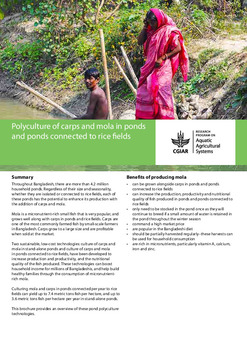Polyculture of carps and mola in ponds and ponds connected to rice fields

Citation
Thilsted, S.H.; Wahab, M.A. (2014). Polyculture of carps and mola in ponds and ponds connected to rice fields. CGIAR Research Program on Aquatic Agricultural Systems. Penang, Malaysia. Brochure: AAS-2014-06
Throughout Bangladesh, there are more than 4.2 million household ponds. Regardless of their size and seasonality, whether they are isolated or connected to rice fields, each of these ponds has the potential to enhance its production with the addition of carps and mola. Mola is a micronutrient-rich small fish that is very popular, and grows well along with carps in ponds and rice fields. Carps are one of the most commonly farmed fish by small-scale farmers in Bangladesh. Carps grow to a large size and are profitable when sold at the market. Two sustainable, low-cost technologies: culture of carps and mola in stand-alone ponds and culture of carps and mola in ponds connected to rice fields, have been developed to increase production and productivity, and the nutritional quality of the fish produced. These technologies can boost household income for millions of Bangladeshis, and help build healthy families through the consumption of micronutrientrich mola. Culturing mola and carps in ponds connected per year to rice fields can yield up to 7.4 metric tons fish per hectare, and up to 3.6 metric tons fish per hectare per year in stand-alone ponds. This brochure provides an overview of these pond polyculture technologies.
Permalink
Date Available
Type
Publisher
Countries
Copyright
CC BY 4.0
Research Themes